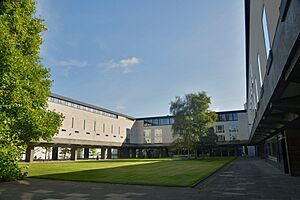Faculty of Philosophy, University of Cambridge facts for kids
The University of Cambridge is a very old and famous university in England. It's where a special way of thinking called the 'Analytic' School of Philosophy began in the early 1900s. The philosophy department is in a building called the Raised Faculty Building. It's part of the Cambridge School of Arts and Humanities. This department is really good! In 2020, it was ranked second best in the UK by The Guardian and the Philosophical Gourmet Report. It was also ranked fifth in the world by QS World University Rankings.
Contents
A Look Back: Philosophy at Cambridge
In 1848, a smart person named William Whewell helped start two new types of exams. One was for natural sciences (like physics). The other was for moral sciences. This "Moral Sciences" exam covered five different subjects. These included moral philosophy, economics, history, and law. At first, not many students took these exams. This was because they didn't lead to a full degree.
Moral Sciences Becomes a Degree
Things changed in 1861. Thanks to ideas from John Grote and Joseph Mayor, Moral Sciences became a full three-year degree course. A special group, the Board of Moral Sciences Studies, was also set up. Law became its own subject. Instead, "Mental Philosophy" (which is like psychology) was added to the Moral Sciences course.
Changes to the Course
In 1867, history was also removed from the Moral Sciences course. This left four main subjects: moral philosophy, logic, economics, and psychology. Around this time, smart students like J.N. Keynes and James Ward graduated. The course became more popular and better. More teachers were hired to help the two main professors. Many colleges, like St. John's and Trinity, also started hiring their own teachers for Moral Sciences. These teachers included Henry Sidgwick and Alfred Marshall.
Philosophy Takes Shape
Later, economics also became a separate subject in 1903. This happened because of the efforts of Alfred Marshall. This change meant the Moral Sciences course focused more on what we now call analytic philosophy. Psychology stayed part of the course for a while. But it slowly became its own separate subject too.
In the first half of the 1900s, three very famous philosophers worked at Cambridge. They were Bertrand Russell, G.E. Moore, and Ludwig Wittgenstein. They helped create modern logic and the ideas of analytic philosophy. In 1970, the "Moral Sciences" department was finally renamed "Philosophy."
It's also important to know that Constance Maynard was the first woman to study Moral Sciences at Cambridge. She finished her studies in 1875.
Philosophers at Cambridge Today
Here are some of the philosophers who teach and do research at Cambridge now:
- Arif Ahmed
- Alexander Bird
- Simon Blackburn (retired)
- Angela Breitenbach
- Clare Chambers
- Tim Crane
- Raymond Geuss (retired)
- Jane Heal (retired)
- Richard Holton
- Rae Langton
- John Marenbon
- Alex Oliver
- Onora O'Neill (retired)
- Michael Potter
- Huw Price (retired)
- Timothy Smiley (retired)
Famous Philosophers from Cambridge's Past
Many important philosophers have worked or studied at Cambridge. Some of them held a special position called the Knightbridge Professor of Philosophy. This job was created way back in 1683, making it one of the oldest teaching roles at the university.
Here are some of the famous philosophers connected to Cambridge:
- Desiderius Erasmus
- Francis Bacon
- The Cambridge Platonists, including Ralph Cudworth, Benjamin Whichcote and Henry More
- William Whewell
- John Grote
- Henry Sidgwick
- John Neville Keynes
- George Frederick Stout
- James Ward
- J. M. E. McTaggart
- Bertrand Russell
- William Ritchie Sorley
- G. E. Moore
- Ludwig Wittgenstein
- Alice Ambrose
- Helen Knight
- Margaret MacDonald (philosopher)
- Margaret Masterman
- C. D. Broad
- Richard Braithwaite
- A. C. Ewing
- Frank P. Ramsey
- Georg Henrik von Wright
- Susan Stebbing
- Casimir Lewy
- Jonathan Lear
- Iris Murdoch
- John Wisdom
- Elizabeth Anscombe
- Bernard Williams
- Amartya Sen
- Jonathan Bennett
- Judith Jarvis Thomson
- Ian Hacking
- Roger Scruton
- Kwame Anthony Appiah
- Alain de Botton
- Quassim Cassam
- Alfred North Whitehead
- Renford Bambrough
- Hugh Mellor
- Jimmy Altham
- Eric Olson
- Dominic Scott
- Serena Olsaretti
- Hallvard Lillehammer
- Susan James
- Peter Geach
- William MacAskill
- David Papineau
- A.W. Moore
- Arthur Balfour


